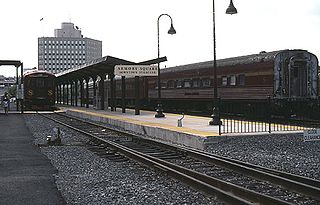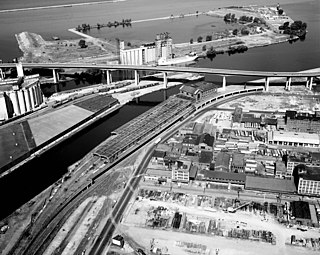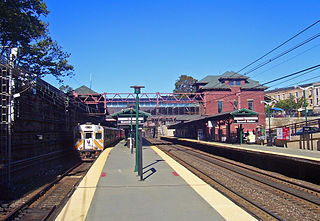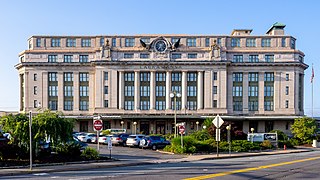
OnTrack was a suburban rail line that operated in Syracuse, New York, from 1994 to 2008. The line ran from the Carousel Center on the city's north side via Armory Square and Syracuse University to Colvin Street, with summer weekend service south to Jamesville, mainly using 1950s-era diesel railcars.

The Delaware, Lackawanna and Western Railroad, also known as the DL&W or Lackawanna Railroad, was a U.S. Class 1 railroad that connected Buffalo, New York, and Hoboken, New Jersey, and by ferry with New York City, a distance of 395 miles (636 km). The railroad was incorporated in Pennsylvania in 1853, and created primarily to provide a means of transport of anthracite coal from the Coal Region in Northeast Pennsylvania to large coal markets in New York City. The railroad gradually expanded both east and west, and eventually linked Buffalo with New York City.

The Main Line is a commuter rail line owned and operated by New Jersey Transit running from Suffern, New York to Hoboken, New Jersey, in the United States. It runs daily commuter service and was once the north–south main line of the Erie Railroad. It is colored yellow on NJ Transit system maps, and its symbol is a water wheel.

The Morristown Line is an NJ Transit commuter rail line connecting Morris and Essex counties to New York City, via either New York Penn Station or Hoboken Terminal. Out of 60 inbound and 58 outbound daily weekday trains, 28 inbound and 26 outbound Midtown Direct trains use the Kearny Connection to Penn Station; the rest go to Hoboken. Passengers can transfer at Newark Broad Street or Summit to reach the other destination. On rail system maps the line is colored dark green, and its symbol is a drum, a reference to Morristown's history during the American Revolution.
The Oswego and Syracuse Railroad was formed on April 29, 1839, and the route was surveyed during the summer of that year. The Company was fully organized on March 25, 1847. The road was opened on May 14, 1848, and ran a total distance of 35.5 miles (57.1 km) from Syracuse, New York to Oswego, New York. In 1872 it passed under the management of the Delaware, Lackawanna and Western Railroad.

The Metro Rail Maintenance Yard or "South Park Terminal" houses Buffalo Metro Rail's cars in a train shed at the former Delaware, Lackawanna and Western Railroad terminal in the Cobblestone District of Buffalo, New York. The property is located at the southernmost fringe of the Central Business District. The station was built in 1917, and was designed to handle both steam trains and steamships. The storage and maintenance facility was converted to its present condition in 1982, following the demolition of the former main terminal concourse building "headhouse" of the DL&W Terminal in 1979.

Newark Broad Street station is a New Jersey Transit commuter rail and light rail station at 25 University Avenue in Newark, New Jersey. Built in 1903, the station's historic architecture includes an elegant clock tower and a brick and stone façade on the station's main building. In June 1984, the station was added to the National Register of Historic Places in recognition of its historical significance.

The William F. Walsh Regional Transportation Center (RTC) is an Amtrak intermodal transit station serving the Syracuse area. It is owned and operated by Intermodal Transportation Center, Inc, a subsidiary of Centro, and is also served by Greyhound Lines, Megabus, and Trailways. Local and regional bus transportation is provided by Centro. Various taxi firms provide service to the Center, as well.

Summit is a train station in Summit, New Jersey, served by New Jersey Transit's Morris & Essex Lines. The station sits between Union Place on the north and Broad Street on the south, with station access via either side, and between Summit Avenue on the east and Maple Avenue on the west. Constructed in 1904–1905 by the Delaware, Lackawanna and Western Railroad in a mile-long open cut, it is one of the few NJ Transit stations with platforms below street level.

Kingsland is a railroad station on New Jersey Transit's Main Line. It is located under Ridge Road (Route 17) between New York and Valley Brook Avenues in Lyndhurst, New Jersey, and is one of two stations in Lyndhurst. The station is not staffed, and passengers use ticket vending machines (TVMs) located at street level to purchase tickets. The station is not handicapped-accessible. Originally part of the Delaware, Lackawanna and Western Railroad's Boonton Branch, the current Kingsland station was built in 1918. The station is currently planned to be closed.

Paterson is a New Jersey Transit commuter railway station located on an elevated viaduct above Market Street in downtown Paterson, New Jersey. The railway through the station is double tracked, for north and south traffic on the NJT Main Line.

Ridgewood is a railroad station operated by New Jersey Transit in the village of Ridgewood, Bergen County, New Jersey, United States. A major transfer station, Ridgewood has two high-level platforms for the Main Line and Bergen County Line.

The Radisson Lackawanna Station Hotel, which was built as the Delaware, Lackawanna and Western Railroad Station, is a French Renaissance-style building in Scranton, Pennsylvania.

Railroad Terminal Historic District is a national historic district in Binghamton in Broome County, New York. The district includes 19 contributing buildings. Four of the buildings were directly related to Binghamton's rail passenger and freight operations, including the passenger station. Five buildings were built as warehouses, and ten were built to house retail activities with residential or office uses on the upper floors. The buildings were built between 1876 and 1910, with a major addition to one of them completed in 1932. This Delaware, Lackawanna and Western Railroad passenger station, with its Italian Renaissance campanile, was built in 1901. For most years of passenger service to Binghamton, Delaware and Hudson Railway and Erie Railroad trains used a different station 150 yards away.

The Montclair-Boonton Line is a commuter rail line of New Jersey Transit Rail Operations in the United States. It is part of the Hoboken Division. The line is a consolidation of three individual lines: the former Delaware, Lackawanna & Western Railroad's Montclair Branch, which ran from Hoboken Terminal to Bay Street, Montclair. The Erie Railroad's Greenwood Lake Division, a segment from Montclair to Mountain View-Wayne, originally ran from the Jersey City Terminal to Greenwood Lake, NY, and the former Lackawanna Boonton Line ran from Hoboken to Hackettstown, New Jersey.

Pocono Mountain is a proposed New Jersey Transit Rail Operations (NJT) station located in Coolbaugh Township, Monroe County, Pennsylvania and is part of a site that was formerly utilized as a summer camp. The proposed station site, which will include a 1,000-space surface parking lot, is located northwest of a multi-phased planned development for this area. Access will be from Pennsylvania Route 611 via Pocono Municipal Road/Mount Pocono Road and a local access road and the platform would be situated east of the track.
The Syracuse and Binghamton Railroad was established on August 18, 1851, and opened for business on October 18, 1854. The road merged in 1856 into Syracuse and Southern Railroad which was renamed to Syracuse, Binghamton and New York Railroad when the company reorganized after foreclosure in 1857.

The Nickel Plate Limited, later known as the City of Cleveland and City of Chicago, was a passenger night train operated by the New York, Chicago and St. Louis Railroad between Chicago and Buffalo, New York via Cleveland, Ohio, with through service to Hoboken, New Jersey via Binghamton and Scranton and the Delaware, Lackawanna and Western Railroad for the Buffalo-Hoboken segment.

Warren was a former station for the Erie Railroad on its main line and on the Mahoning Division's first subdivision between Cleveland and Pymatuning station. Along the main line, the next station west towards Dearborn Station was Leavittsburg, while east towards Pavonia Terminal was Niles. The station was located 585.7 miles (942.6 km) from Pavonia Terminal and 412.8 miles (664.3 km) from Dearborn Station.
The Interstate Express was a long-distance passenger train operating between Syracuse, New York, and Philadelphia, jointly operated by the Reading Railroad, the Central Railroad of New Jersey and the Delaware, Lackawanna and Western Railroad. These lines offered a long distance overnight line in Train 1301 (north-bound)/ 1306 (south-bound). Connecting service by the Baltimore and Ohio Railroad offered continuing service south from Philadelphia to Washington, D.C.


















